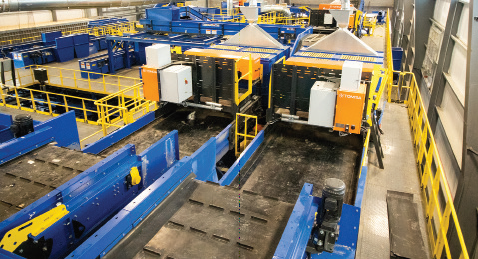Republic Services’ new MRF achieves extremely high recovery of mixed paper, resulting in clean and sellable output with minimal QC sorting, by using equipment and methods from Van Dyk Recycling Solutions.
When it comes to dealing with incoming material at their new MRF in Plano, Texas, Republic Services says they are taking a unique approach with the technology on the sorting line. The MRF serves more than 510,000 residents and 2,500 commercial customers throughout the Dallas–Fort Worth metro area, using equipment designed to specifically make intelligent sorting decisions with a high degree of flexibility. To achieve extremely high recovery of all mixed paper, resulting in clean and sellable output with minimal QC sorting, Republic uses equipment supplied by Van Dyk Recycling Solutions, along with the supplier’s Positive Sorting method.
 The method uses a combination of non-wrapping screens and optical sorters to intelligently separate and improve the quality of fiber recovered from the stream. Optical units shoot positively on paper at the front end by identifying its material characteristics and positively separating it from the stream.
The method uses a combination of non-wrapping screens and optical sorters to intelligently separate and improve the quality of fiber recovered from the stream. Optical units shoot positively on paper at the front end by identifying its material characteristics and positively separating it from the stream.
According to Van Dyk, traditional methods of removing contaminants from paper, based on size, shape and density, create too much collateral damage for today’s high purity standards. With a higher-purity fiber stream headed to quality control, Republic’s new plant will need fewer manual sorters to remove non-fibrous materials.
In addition, to prepare material for positive sorting, in which optical units perform best when the material is properly pre-sorted and evenly spread on the belt, a non-wrapping ONP screen first separates paper from containers.
Van Dyk says their non-wrapping screen has a very large shaft with specially shaped and spaced stars. Because of this design, it incurs virtually no film wrapping and continues to separate materials at peak ability for an entire shift at full capacity. The screen takes as little as 10 minutes to clean and because it has larger and fewer stars, the need for replacement parts is significantly reduced.
This non-wrapping screen-to-optical setup gives Republic’s facility an unprecedented degree of flexibility, according to Van Dyk. With the ever-evolving ton, many facilities are constantly facing changes in their stream’s composition, which brings with it new challenges.
Traditional screening approaches can struggle to adapt to a changing stream and will continue to produce degrading fiber quality and require high maintenance costs. But having multiple sensor optical sorting units on primary separation prepares a plant for future changes in incoming material. Plus, the optical units can be reprogrammed on the spot to recognize and recover a different commodity, should the incoming stream undergo drastic changes.
At Republic’s new Plano MRF, there are also four separate fiber storage bunkers to make OCC and three different grades of mixed paper that can be baled separately or blended.
Van Dyk’s design in Plano also incorporates a mono-platform and second-level system access, which allows sorting personnel to safely access all QC lines on a central platform, without walking on the operating floor.
Additionally, the system features an elliptical screen for film removal, another series of optical sorters to separate plastics, a system-wide dust collection network, and a glass cleanup system, proven to recover over 95 percent of clean glass via a specialized vibratory screen and density separator.
Finally, a Bollegraaf HBC-120S baler is going to be used for fiber and OCC, and is capable of baling all commodities
